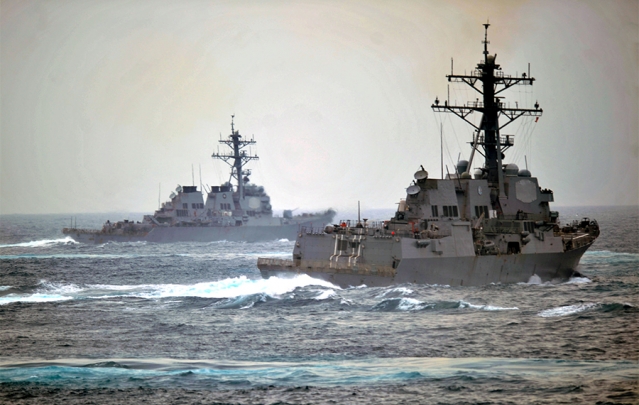Missile Attacks on the USS Mason: Principles to Guide a U.S. Response
Cmdr. Jeremy Vaughan, USN, Michael Eisenstadt, and Michael Knights/ The Washington Institute/October 12/16
After three antishipping attacks in two weeks by Iranian-backed Houthi rebels, Washington should take firm steps to prevent this from becoming the new normal off Yemen’s coast.
On October 9, the destroyer USS Mason was unsuccessfully targeted by two antishipping missiles fired from Houthi-controlled parts of Yemen’s Red Sea coast. The ship had recently joined the destroyer USS Nitze and the amphibious transport ship USS Ponce to patrol the area north of the Bab al-Mandab Strait, a deployment ordered in response to the destructive October 1 Houthi missile strike on the United Arab Emirates logistics ship Swift. The Mason was reportedly attacked again earlier today, raising the urgent need for a strong, clear response.
DETAILS OF THE ATTACKS
According to anonymous U.S. officials, the Mason fired defensive salvos to thwart attempted missile strikes while sailing in the Bab al-Mandab today, though the exact circumstances of the incident are still emerging. As for the October 9 attack, an antishipping missile was fired toward the Mason at around 7 pm, followed by a second missile sixty minutes later. To counter the attack, the ship fired two Standard Missile 2 interceptors and one RIM-162 Evolved Sea Sparrow Missile (ESSM); it also activated a Nulka hovering “seduction” decoy to draw the missiles away. The SLQ-32(V) electronic countermeasures suite may have been used as well, along with super rapid bloom offboard countermeasures (SRBOC) chaff and decoy launching systems. The ship’s “hard defense” systems — such as the Phalanx close-in weapons system (CIWS) and the Mark 45 Mod 4 surface gun — did not open fire. Both missiles appear to have crashed into the sea, whether due to U.S. countermeasures or malfunction.
Today’s attack removes doubt as to whether the missiles were specifically aimed at the U.S. ships. Judging by the October 1 attack on the Swift, in which Houthi cameramen shadowed the target in a small boat hours beforehand, there is reason to suspect the operators knew U.S. vessels were present in both of the Mason attacks.
The timing of the October 9 incident lends credence to these suspicions. On October 10, the Houthi-run SABA news agency quoted a rebel source who denied that the Iranian-backed movement had attacked a U.S. ship. Yet the missiles were fired less than twenty-four hours after 142 people were killed by a Saudi airstrike on a funeral in the Yemeni capital of Sana. Rebel leader Abdul-Malik al-Houthi publicly blamed America for that incident, calling the U.S. government “the first and foremost party responsible for the carnage” and noting that “the Saudis are killing Yemenis by means of U.S. weapons and military aircraft. They strike where Americans pinpoint and allow.” These statements were amplified by Iranian and Russian media, with the latter reporting the recovery of U.S. weapon parts from the bombed funeral site. Moreover, on the same evening the Mason was first attacked, the Houthis fired two Scud missiles toward the Saudi city of Taif. Both Scuds appear to have been intercepted by U.S.-supplied Patriot missiles, though Houthi propaganda falsely claimed that they had hit their targets, airing old footage of a Saudi F-15 crash as “proof.”
THE NEED TO DETER PROXY ATTACKS ON SHIPPING
The balance of evidence seems to show that the Houthis and/or their Yemeni military allies have intentionally struck out at U.S. ships after the funeral bombing, either out of genuine anger or to use the bombing as cover for preplanned attacks. Whatever the case, it is a surprisingly aggressive move, breaking the unwritten golden rule of proxy warfare: “Don’t attack the patron of your enemy unless they directly engage you in combat.” Iran’s potential role in instigating or encouraging the attacks is unknown. Houthi relations with the Islamic Republic resemble the Iran-Hamas relationship more than the Iran-Hezbollah relationship — that is, the Houthis are autonomous partners who usually act in accordance with their own interests, though often with smuggled Iranian arms and other indirect help.
Although the attacks on the Mason were ineffective, they demonstrate the urgency of sending strong signals that antishipping attacks must cease immediately. The United States and other countries need to show the Houthis in no uncertain terms that they cannot attack U.S. or allied interests with impunity. A strong message must also be sent that Iran cannot use the Houthis to attack international shipping; inaction would likely send the exact opposite message. The Iranian regime has observed the weakness of Washington’s response to its hostile proxy actions in the past, including Hezbollah’s 1983 bombing of the U.S. embassy and Marine barracks in Beirut, the Iranian-commissioned 1996 Khobar Towers bombing in Saudi Arabia, and the 2011 assassination plot against the Saudi ambassador in Washington.
PRINCIPLES TO GUIDE A U.S. RESPONSE
Whatever course of action Washington chooses, it should base its response on four key principles: Set achievable objectives that build U.S. credibility. Washington should not draw any redlines that it is unwilling to enforce. By firmly pushing back against any early efforts to test its redlines, the United States can save itself a great deal of grief and effort down the road. For example, if Washington and its allies declare a prohibition on antishipping missile launches, then any future missile strikes (successful or not) must have significant consequences for the Houthis.
Demonstrate a willingness to accept risk. The United States has deployed forces into the Bab al-Mandab and shown it can counter Houthi antishipping attacks. Now it should keep forces there for as long as the Houthis seem bent on testing U.S. resolve. It should also increase monitoring and enforcement of the UN embargo against Iranian arms transfers (i.e., UN Security Council Resolution 2231). In addition to constricting Iranian resupply of the Houthi missile arsenal, this could signal the rebels that further attacks will result in a more general disruption of their proxy relationship. Moreover, the U.S. Navy should put together a maritime coalition to keep strategic waterways open, as it did when escorting tankers during Operation Earnest Will in 1987-1988. Toward this end, it could draw on the twenty-nation Combined Task Force 151, presently focused on counterpiracy operations off the Horn of Africa, to help protect commercial shipping in the Bab al-Mandab and Red Sea (this depends on the force’s current legal status; Washington and its partners may need to change CTF 151’s formal mandate to redeploy it, or create a new force with similar parameters and participants).
Divide Iran from the Houthis. The rebels are not yet part of Iran’s transnational threat network: they are a local organization with local motives. When possible, then, the United States should avoid actions that drive them closer to Iran (e.g., kinetic strikes), instead favoring approaches that drive wedges between them. For instance, a stronger blockade could reduce Iran’s ability to tangibly help the Houthis, while more active support for an equitable peace deal could offer them guarantees that Tehran cannot.
Be ready to respond disproportionately. Washington needs to create the perception that it is willing to go beyond deterrence-by-denial (i.e., using defensive measures to render antishipping attacks ineffective). This means raising the threat of deterrence-by-punishment, which could introduce uncertainty into Houthi and Iranian cost-benefit calculations and make the United States a more unpredictable adversary. Aggressive U.S. reconnaissance of the Houthi-controlled coastline could serve as an immediate warning. If this fails, disproportionately severe airstrikes on antishipping missile storage sites, launchers, or command posts might be a next step.
**Cmdr. Jeremy Vaughan, U.S. Navy, is a Federal Executive Fellow at The Washington Institute who has completed multiple deployments to the Persian Gulf. Michael Eisenstadt is the Kahn Fellow and director of the Military and Security Studies Program at the Institute. Michael Knights is the Institute’s Lafer Fellow. The views expressed herein are those of the authors and do not reflect the official policy or position of the U.S. Navy, U.S. Department of Defense, or U.S. government.




















